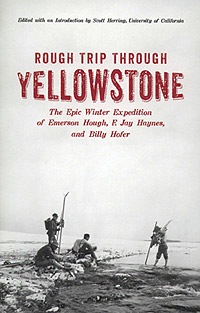 Talented journalist Emerson Hough was sent west in 1894 by Forest and Stream magazine to document the number of buffalo (estimated to be between 150 and 200 head) remaining within the borders of Yellowstone Park. Scott Herring edits this compilation of 14 articles he wrote about the trip, subtitled The Epic 1894 Winter Expedition of Emerson Hough, F. Jay Haynes, and Billy Hofer.
Talented journalist Emerson Hough was sent west in 1894 by Forest and Stream magazine to document the number of buffalo (estimated to be between 150 and 200 head) remaining within the borders of Yellowstone Park. Scott Herring edits this compilation of 14 articles he wrote about the trip, subtitled The Epic 1894 Winter Expedition of Emerson Hough, F. Jay Haynes, and Billy Hofer.
Hough headed to Yellowstone in March, under the assumption that bison would be concentrated in winter feeding grounds and easier to observe. What he didn’t know is that Yellowstone often clings to winter, with temperatures dropping to -40 degrees F.
The mode of travel was 10 – 12-foot wooden skis, propelled (or braked) with one long wooden pole. Hough had never skied before, and his introduction was one afternoon’s lesson with seasoned guide Billy Hofer. Each man dressed in layers of wool, with a canvas outer coat to cut the wind, and each lugged a camera: Hofer’s weighed over 25 pounds and Hough’s was more than 10 pounds.
“No possible regimen or system of exercise would put a man in as splendid shape as a month’s trip through the mountains on the skis,” noted Hough, optimistically. The enormous strength and fortitude required to duplicate this 200 mile trip is daunting even with today’s modern equipment and clothing.
While in Yellowstone, the journalist observed the arrest of a notorious buffalo poacher and his excellent reporting helped propel Congress into passing the Lacey Act, giving teeth to the National Park Service’s efforts to prosecute poachers.
He also reported on a very controversial proposal to portion out northeast corner of the park for a railroad spur that would have connected the mines Cooke City to major lines of transport. The proposed “segregation” of land would have included crucial winter-feeding grounds for thousands of elk.
Hough’s skillful reporting gives readers an intimate look at the conditions and character of Yellowstone Park during the latter part of the 19th century. “It was a journey for a lifetime,” he wrote, and contemporary readers are fortunate to be able to travel along with him in this historically significant and thoroughly entertaining read.
The book includes nine black and white photographs by F. Jay Haynes, dubbed the “Official Photographer of Yellowstone National Park” and an important pioneer in the field of photography. Editor Scott Herring teaches writing at the University of California Davis. He worked in Yellowstone Park and maintains a strong bond with the area.
– Judy Shafter